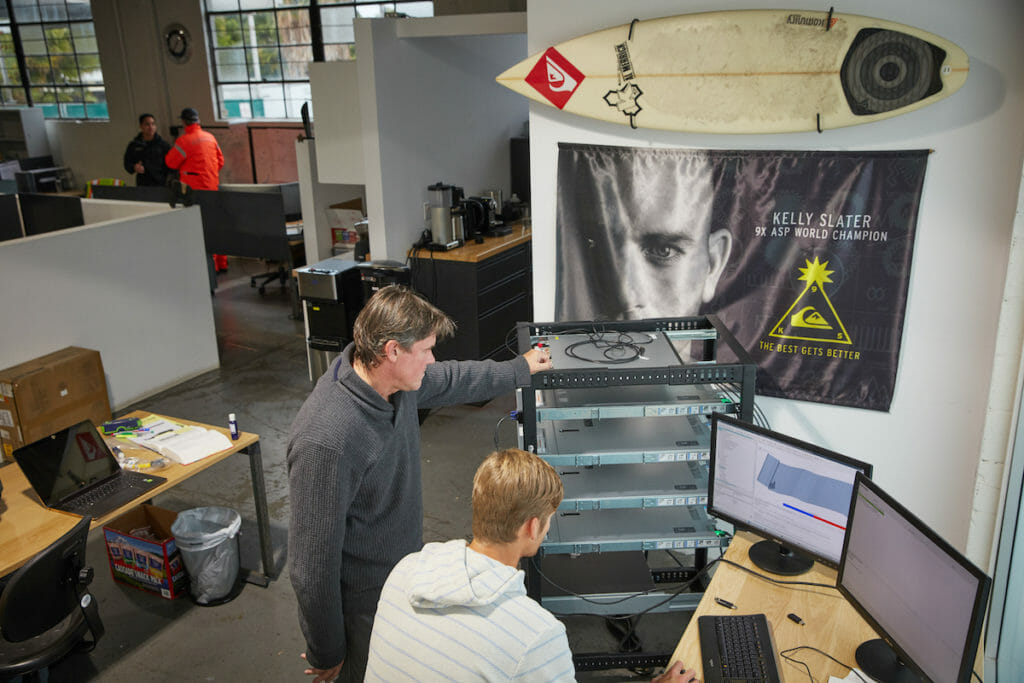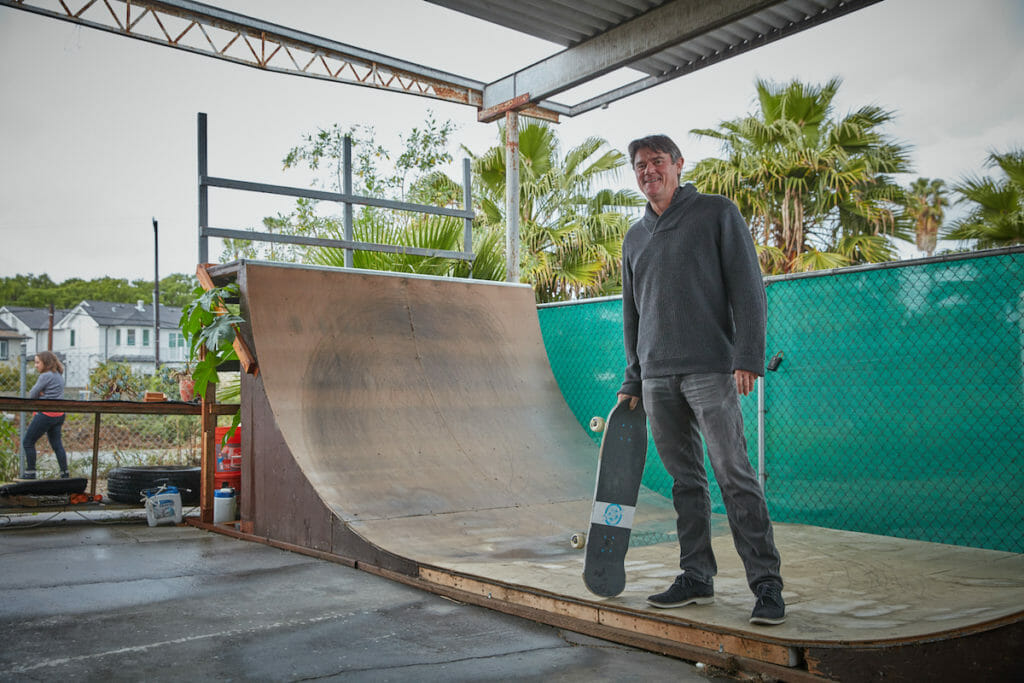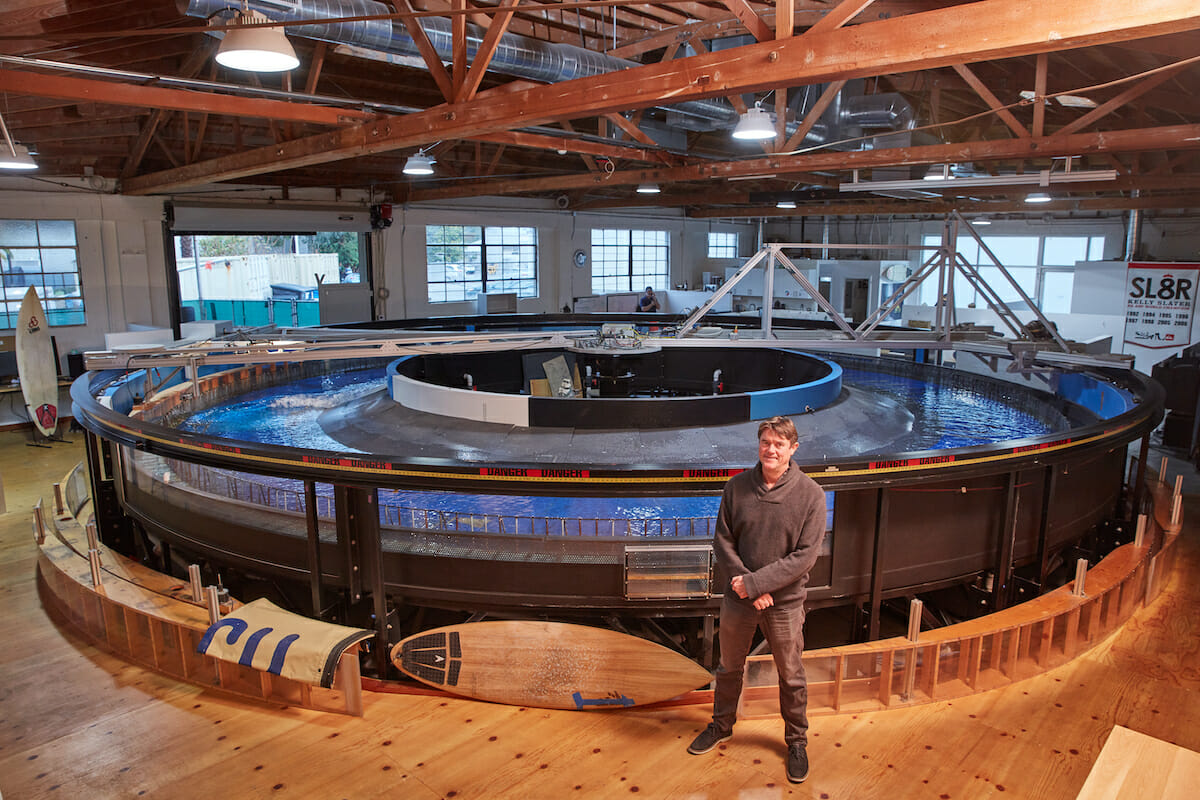What does it take to create the perfect wave? Turns out it’s just a bold, innovative engineer, a team of technicians and a superstar surfer.
Past a row of low-slung office buildings where a Culver City street dead-ends, behind the towering skeleton of a high-rise-in-the-making and tucked into the leafy bank of Ballona Creek, lies a small, whitewashed warehouse with a single door. Inside, the small foyer gives way to an airy, high-ceilinged space like many in L.A. — open-plan cubicles, a conference room with hand sanitizer on the tables, a few potted palms and surfboards for a casual, beachy effect.
But past the cluster of desks, colorful print-outs and whiteboards with indecipherable hand-written equations is something else: a massive, round water basin decked out with instruments, digital clocks and a foil along its perimeter pushing the water in an endless circle. This is where Adam Fincham and his team designed what is widely considered to be the best artificial wave in the world.
In a town that’s synonymous with cinematic contributions more than scientific know-how, Fincham is a heavyweight who may never become a household name. Instead, the 50-something-year-old mechanical engineer with floppy hair, an untraceable accent and boyish enthusiasm has become an improbable star of the surf world. His work has taken him from the University of Southern California to France and then back to USC where he oversees a handful of graduate projects.
For most of his career, Fincham researched turbulence, the unpredictable force that disturbs a fluid. Fluid, Fincham says patiently, is anything that flows, including air, gases and yes, water.
It would be a while, though, before waves began to interest him, despite growing up on an island. Fincham grew up in Kingston, Jamaica, the middle child between two sisters and the son of a social worker and biochemist. Early on, he was exposed to the halls of academia at the local university, where his father taught and hobnobbed with other professors. He was also exposed to engineering. It’s hard to replace things on the island, Fincham says, and he happened to have an aptitude for fixing stuff that broke.
Yet Fincham’s eventual career path was arguably the result of a twist of fate more than early foundations. During high school, one of his teachers assigned him the classic essay: What do you want to be when you grow up? Stumped, Fincham went to the library for ideas.
“[I] found a little book that said, ‘Careers, A to Z,'” he says. “I opened it up and the first one there was aerospace engineer. It sounded really cool.”
So cool, in fact, that he not only wrote his essay about it, but when it came time for college, he traded the Caribbean for Los Angeles and lofty, scientific goals.
It was during a stint in France, however, that Fincham was first exposed to wave-generation research. He was living in Grenoble, a town at the foot of the Alps, during the late 1990s and a number of European labs he worked with had wave tanks. Fincham, though, was focused on vortices, essentially a branch of turbulence research, and his next project — along with the birth of his son — led him back to USC in the early 2000s.
He started to work on other projects like ocean acoustics and, in tandem with marine biologists, he tried to figure out how turbulence affects the movement of plankton. That project, he says, linked biology and physics.
“The plankton themselves can swim, but the turbulence moves them around,” Fincham says. “So you see who controls their destiny.”

The problem with turbulence, according to Fincham, is that it’s non-linear. It’s the phenomenon that causes cigarette smoke to swirl in the air, aneurysms to occur in the body and huge gyres to form in the ocean. It has stumped scientists for more than a century, mostly eluding prediction and now relying on computers to handle its dense math. Fincham says it’s a problem so complex even Albert Einstein gave up trying to solve it.
That Fincham, in contrast, embraced turbulence as a career path may say something about why he jumped on board when a pro surfer he’d never heard of came looking for someone to build a perfect wave — an elusive concept of mythical proportions.
Kelly Slater, the best surfer of his generation, had long dreamt of building a human-made wave that would be as good, if not better, than the real thing. In Fincham, he found the person who could bring his dream to life.
“I don’t think really anybody in the department knew who Kelly was,” Fincham says. “Except the students.”
Still, the wave project was appealing. “Surfing was a cool, sexy thing,” Fincham says. “Most of us in the department at the time at USC were working on more boring, military things.”
The wave project introduced a new element not only into Fincham’s career but also in his imagination.
“[Kelly] had a vision of something, of the perfect wave,” Fincham says. “I didn’t know quite what that was. The concept of the pure surfing wave was totally different from most other things. It’s more about, almost artistically, what is the perfect shape of a wave for a surfer? Which is different from what you normally would be doing, trying to study the waves and understand how they move and their properties.
“After a couple of years in, it got more interesting and more serious. And we stuck it out all the way through this, with the prototype here [in Culver City], and computer modeling, and then we built the Surf Ranch. That was a big thing.”
After more than 10 years, Surf Ranch is Fincham and Slater’s embodiment of a surf Mecca. It’s surreal, like a desert mirage set in the agricultural town of Lemoore, California, 300 miles northeast of Los Angeles and nowhere near a beach. Surrounding the property, which is bigger than a football field and hidden behind endless wooden fences, is flat farmland stretching to the horizon. But inside is a miracle of engineering: a giant, rectangular basin with a foil that produces a seemingly impossible perfect wave.
That wave “is Adam’s baby,” says Ken Lucas, a lab technician at the Kelly Slater Wave Co. “The big ideas are his.”
Lucas has been working with Fincham since the beginning of the wave, when the project was a tiny start-up, brand-new after its birth at USC. With a background in prototyping big projects, he answered an ad on Craigslist and the wave, he says, seemed like it was right up his alley. He met Fincham and started the next Monday.
In previous roles, the “ideas person” would often give Lucas a drawing laying out the work and he’d take that drawing and build it out. At the Wave Co., he says, “it’s a little different.”
“Me and Adam would talk, as detailed as we can, but there were very few drawings handed to me. So we’d have to nail down the idea and concept in other ways,” Lucas says. “He would describe it by moving his hands through the air, or he might lay some sticks on a table and say, ‘It’s kind of like this,’ and I’d go to my desk and do what I can. I call it a chicken-scratch drawing — a really simple concept drawing — and add dimensions to it.”
That process, along with having engineer Alex Poirot and others on the team, worked. Fast-forward a decade and Fincham, his team and Slater have created a kind of miracle of engineering. The wave’s basin is no longer circular. After three years of testing, Fincham abandoned that model in favor of a rectangular, or linear, version, and the resulting machine has become a magnet for professional surfers from around the world. Dubbed “Surf Ranch” for its agricultural setting, Fincham’s opus is winning him the kind of admiration typically reserved for, well, Hollywood stars.
Since the wave’s unveiling in September 2017, Fincham and his work have been well documented. Publications from Science to The New Yorker have written about it, sometimes in breathless terms. Even William Finnegan, the esteemed New Yorker reporter who won a Pulitzer for his surf memoir, “Barbarian Days,” was reduced to fanboy status when tasked with writing about Slater and Fincham’s creation.
It was still early in the morning on September 20, 2017, the day of Surf Ranch’s debut as a competitive venue. The air was already hot, thick with the smell of fertilizer, and some of the world’s top surfers were assembled, ready to go head-to-head on the human-made wave. Ostensibly, the event was about the success of the surfers in a novel, non-ocean venue. But for Fincham and his team, the event was a proof-of-concept showcase — and something of a revelation, too.
For years leading up to that day, Fincham says his mantra was simply, “make the wave, make the wave, make the wave.” But he and his team hadn’t stopped much to think about what they were making it for.
Now, on this plot of land nowhere near the beach, the wave’s very reason for existing was under a global spotlight. A heavy-set Tahitian man known for towing famous pros into his local Polynesian waves rode a jetski in the basin. A team of herculean lifeguards, plucked from big-wave rescue teams, stood assembled on the ramp. Crowds of onlookers and media streamed into the venue, decked out in sun hats and kicking up dust.
Fincham, meanwhile, was conspicuously out of place. Among the throngs of visitors flocking to the basin’s edge and milling around the property, he stood watching, eyes trained on the wave. His work was on display before hundreds of people on-site and countless surf fans on a livestream, waiting to see what the dream machine would do next.
There were countless things that could go wrong: The water that got pushed across the basin to make the wave had to flow back into the system, dampening the energy and cycling back within minutes. The gigantic foil — a behemoth, real-life version of the model in Culver City — was designed with innumerable tiny parts and lines of code, which all had to work in tandem, over and over. Here, again, Fincham was the one to fix broken things.
Lucas knows this well. “Adam is one of the more intelligent people I’ve ever worked for, or with,” he says. “It’s hard to know what his thinking process is. Maybe if I was as smart as he was, I would get it — or as well-educated in wave science, I might understand better the direction he’s going. I mean this with all affection — he’s a bit of a mad scientist, you know? It’s crazy and it’s really cool.”
Plus, Lucas says, he and Fincham have a similar sense of humor. That humor is something that makes Fincham relatable; a point of connection that doesn’t require intimate knowledge of computational fluid dynamics, which he casually calls CFD.
After the sun had set on Surf Ranch’s debut and the wave was put to bed for the day, I experienced his unexpected exuberance. At Lemoore’s Tachi Palace, the Indian casino that doubles as the wave’s unofficial après-surf spot, Fincham once drew, on the back of a cocktail napkin, a diagram of the wave’s basin. By then, he had already been thinking about the linear basin for a decade or more and done an untold number of interviews about the mechanics. Yet, with slot machines chiming behind him and the whirring of the roulette table nearby, he was excited, willing to walk a reporter through the science in the simplest terms possible.

Recently, back at his office in Culver City, his gleeful enthusiasm and profound patience were still there, amid the clicking of computer keys and the pouring rain that preceded L.A.’s citywide lockdown due to COVID-19. A few days afterward, he, Lucas and the team began working from home.
“I didn’t know how that was going to feel, I had no idea,” Fincham says, recalling the wave’s unveiling in 2017. “Seeing the wave itself was something. But then seeing the buzz of the tournament and athletes on the wave and all of this, that’s a whole different level. That was something I didn’t ever imagine.”
Fincham has also gotten to enjoy his creation in other ways. “Surfing my own wave is the best,” he says, but “watching my son surf my wave is the best thing ever. He loves it. He’s 16 now, he’s been surfing it for a little bit.”
This positive conclusion to a decade-long project might have seemed like a good time to hang up the wetsuit, to return full-time to USC, where Fincham is now collaborating on research of turbulent combustion — an “even harder problem because you have turbulence and now it’s on fire.”
Instead, he’s still thinking about the perfect wave — and maybe more, as a second site is under construction in Palm Springs. “I think [there’s] an appetite for maybe something better,” he says. “What else can we do with this? I think everyone will be glad to see how fine of a product can we deliver at these other venues? That’s a challenge in its own right. And then, what will people want next? That’s hard to say.”

